The information and pricing norms contained in this article are from 2016. Please be aware that it may no longer reflect economic realities, which have changed drastically in the intervening years. We have produced updated content on this subject, reflecting the nature of the menswear market in 2023, entitled “$200 Suit vs. $2000 Suit,” available both as a YouTube video and an article!
While many men assume that a suit is just a suit, all menswear garments come in different qualities and price ranges that massively impact what they are like to wear and style; failing to distinguish between these realities is like failing to distinguish between cars like a Tata and a Bugatti.
In many aspects of Classic Menswear, you get what you pay for, and the purpose of today’s article is to illuminate the differences between a suit that costs $100 and a suit that costs $1000. Understanding the hallmarks of each will ensure that you understand your purchase and are spending your money wisely.
Understand Genuine Quality to Assess Real Value
We know what it’s like to buy suits on a budget!
Today, Raphael owns suits that cost everywhere from $5 to $5000. When he first became interested in menswear, $100 was a lot of money to spend on a suit, so Raphael took the time to research manufacturers, understand quality hallmarks, and assess genuine value.
These skills allowed Raphael to determine what truly made a suit high-quality and not to rely only on the price tag for guidance: that’s how he managed to snag this A. Caraceni suit from Milan, one of the most renowned tailors in Italy, for just $80, when new it would easily cost $5000.
The purpose of today’s article is to share with you all that Raphael has learned so that you will know what to expect from suits at various price points. By understanding these norms, you can decide for yourself whether an expensive suit is worth the investment, and what to avoid when it comes to cheap suits with very poor cost-per-wear.
The Features of a $100 Suit
$100 Suits Allow Little Margin for Genuine Quality
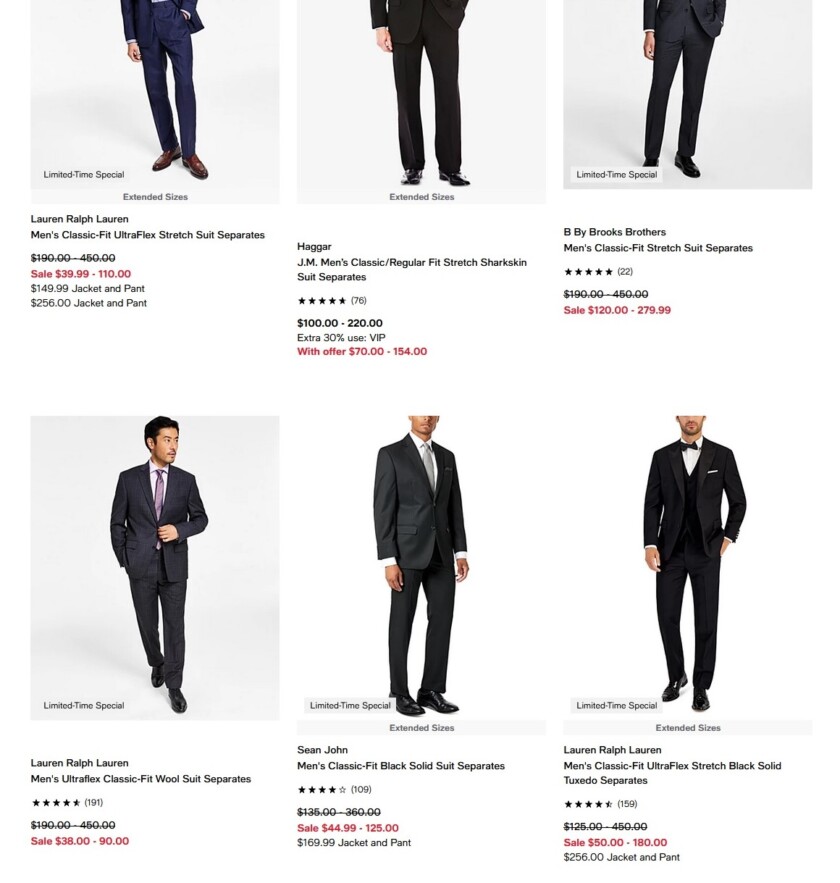
Cheap suits are sold emphasizing low prices, but keeping costs minimal often requires sacrificing quality.
Suits typical of the $100 price range are sold by retailers who focus on the fact that their products are inexpensive: brands like Jos. A. Banks, H&M, Men’s Wearhouse, and the like. These retailers hope that you will be so impressed by the low prices that you won’t bother to assess the quality of the garment: if it’s so cheap, why wouldn’t you buy it?
But what are you getting at this very low price point?
Construction
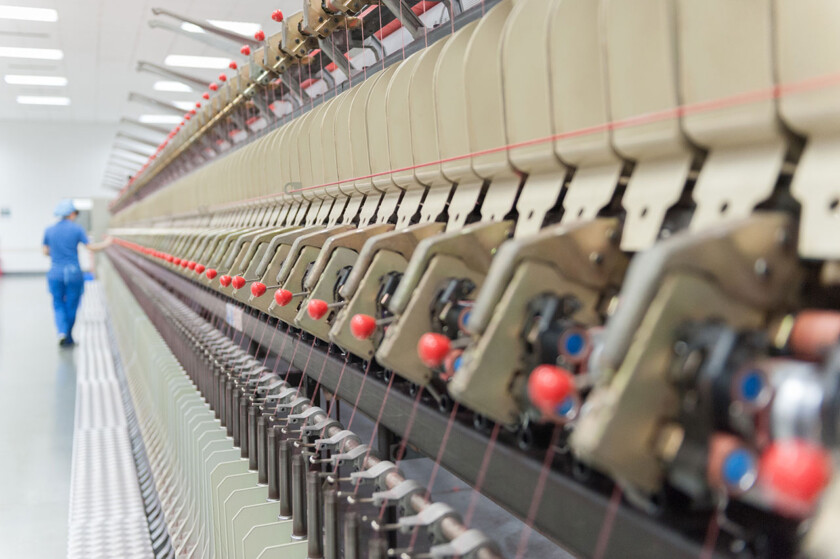
Inexpensive suit production is almost entirely mechanized to reduce labor costs.
$100 suits are almost entirely machine-made and usually sewn together in two or three hours or less. There is none of the handiwork that is essential for ensuring flexibility and a drape that adapts to your body. But at this price point, manufacturers cannot afford to pay the additional labor costs for handwork.
Shell and Lining Materials
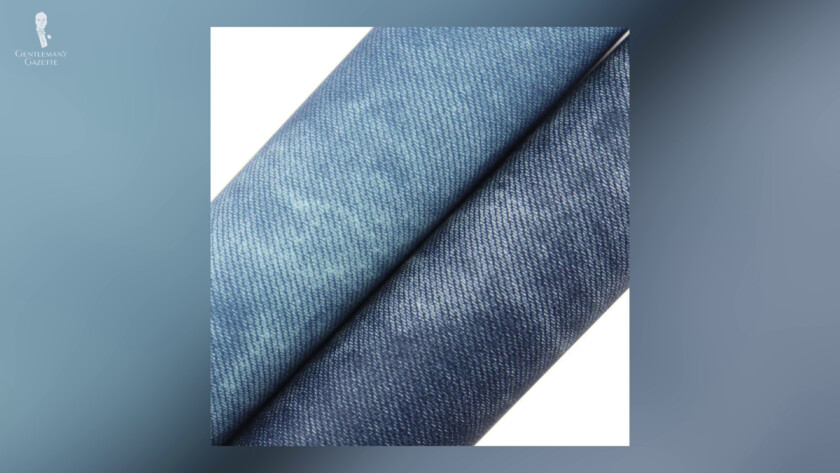
Synthetic fabrics are favored for cheap suits because fo their low cost, not because of their features or functionality.
Raw materials are some of the most expensive components of a suit, so to keep costs low, inexpensive suits have to be made from lower-quality fabrics.
The fabric of a $100 suit is usually stretched with polyester, nylon, or other artificial fibers. Even if natural materials, like cotton or wool, are employed, they tend to be of the lowest quality possible.
In glossy advertising photos, the $100 suit may not look that different, but as soon as you touch it, you can immediately tell that the fabric of both the shell and the lining is of low quality: it simply is stiffer, less comfortable, and you’re more prone to sweating in it because of the stuffy, insulating nature of the fabric.
See all of our fabric content
Interlining
What is a suit’s
Interlining?
When you start out with fabric, you have a two-dimensional surface. That surface, which is the shell of the suit, is usually attached to a lining that touches your skin. Between these two layers, there is another layer of fabric that helps the entire garment maintain its shape, especially around structured portions like the chest and shoulders. This fabric is the interlinig.
For a $100 suit, the interlining is of very low quality and is glued to the fabric to hold everything in place. This arrangement works for a short time, but it also acts as an insulator, so you’re much more likely to overheat and sweat. Over time, and especially if the garment becomes wet, this interlining will come loose and you will see bubbles forming on the fabric, especially on the lapels. This problem appears very odd and sloppy and it is one of the easiest ways to identify a cheap suit.

Loose interlining creates blistering bubbles on the chest of a suit.
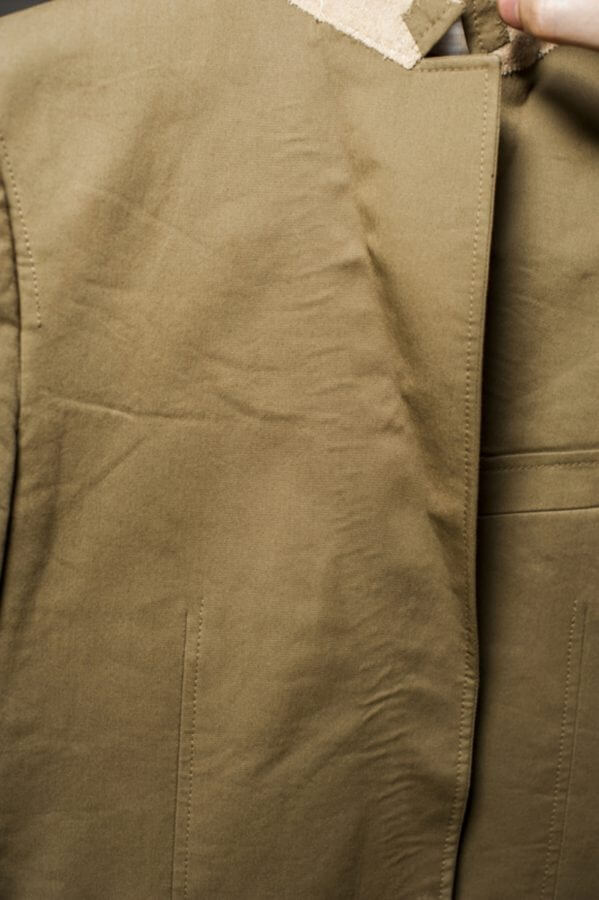
Loose interlining is especially evident under the lapels.
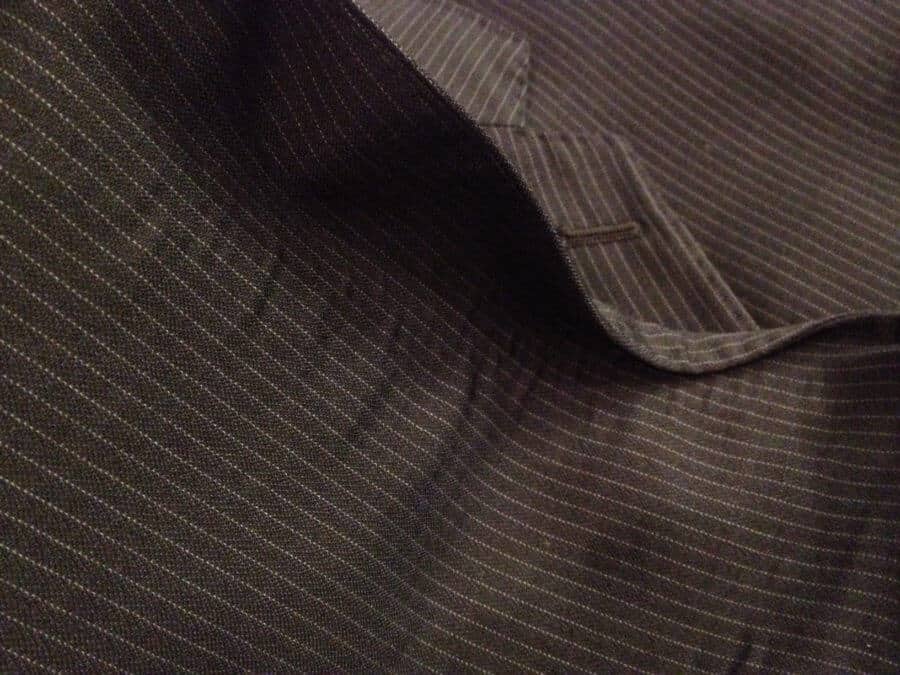
Blistering bubbles from loose interlining radiate out from the lapels of a jacket.
Learn more about interlining
Attention to Details
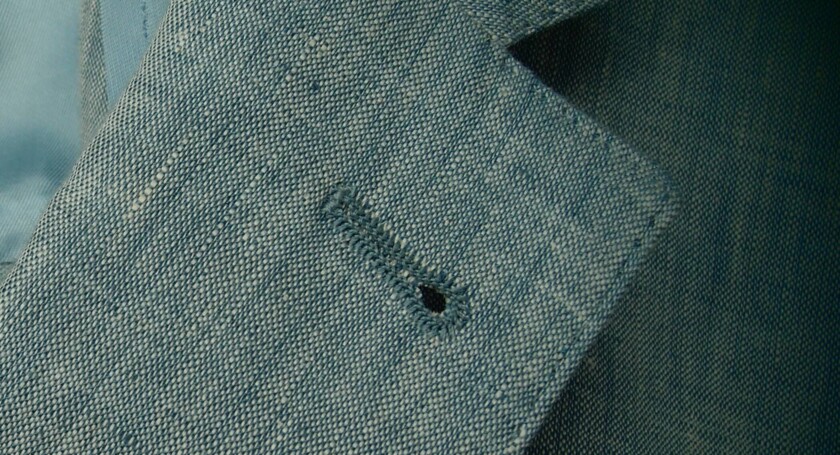
Sewn and then cut buttonholes with frayed edges are typical of cheap suits.
When keeping prices low, it is almost impossible to expend money on attention to fine details. For instance, when making buttonholes, they are first sewn and then cut on a cheap suit because this method is more expedient, even though it leaves behind frayed threads.
Disregarding functionality and an emphasis on a low price point defines all aspects of cheap suit detailing: buttons are made from plastic, the lining is polyester, visually attractive detailing like pick stitching is absent: everything is done only to keep costs low.
Spot the details that indicate a cheap suit!
Cut
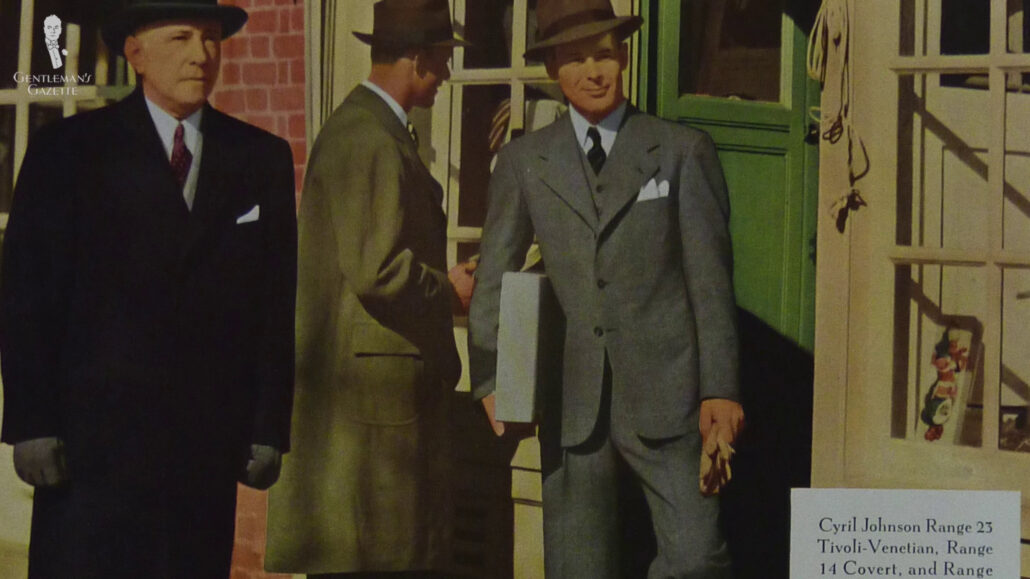
A boxy suit silhouette popular in the 1940s.
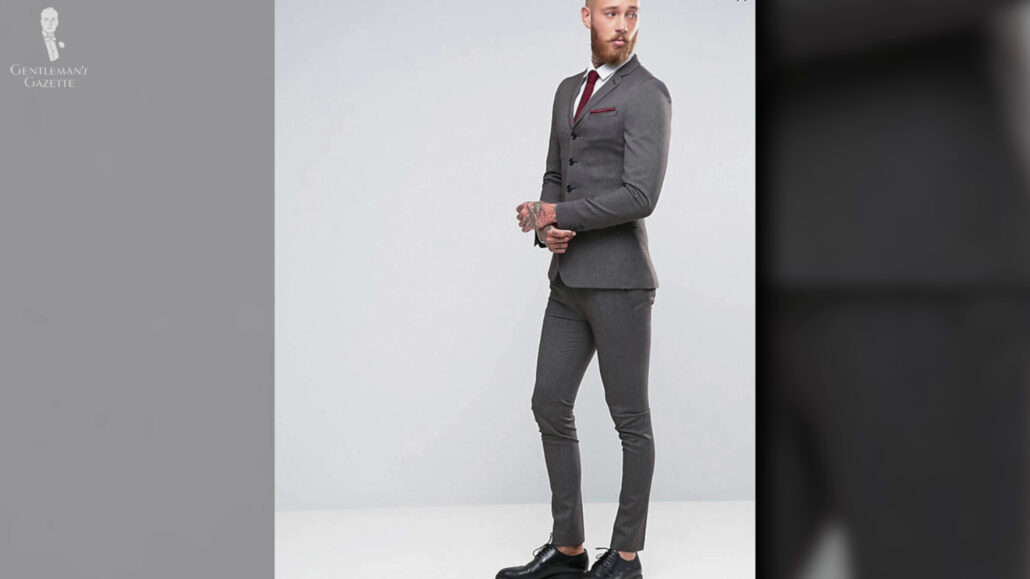
The skinny look popular since the mid-2000s.
The cut of a $100 suit can, in theory, be as good as the one of a $1000 suit or a more expensive suit, but in practice, that’s rarely the case. More often than not, $100 suits are either very fashion-forward, with features like very skinny lapels so that they can be sold while a trend is still hot, and you can only wear them while that trend is still popular, or they’re simply old-fashioned to appeal to convention, and the cut is boxy and bulky.
Learn how any suit should fit
Pattern

It’s hard to fit in, literally or figuratively, with the cookie-cutter patterns of modern suits.
In order to tailor a suit, one needs a pattern. On a $100 suit, this pattern is the same for everyone; there’s no custom element, and so it will never fit you perfectly: it has been cut entirely for an imagined ideal. The patterns are also cut only for looks and not functionality: for a slim silhouette, every aspect of the suit is made slim, even the sleeves. As a result, mobility in the suit and the ability to do basic tasks, like raising your arm to hail a cab, are severely compromised.
Be wary of Armholes that are
Deep-Cut
When armholes are deeply cut, they cause the entire body of the jacket to shift every time you move your arms, but especially when you lift or raise your arms. This pulling and tugging can drastically alter the lines of your suit. Furthermore, the weight and structure of the jacket can restrict your arm movement, effectively binding your arms in place and making them more difficult to move.
Learn why modern cuts only work for one body type
$100 Suits Are Cheap for a Reason
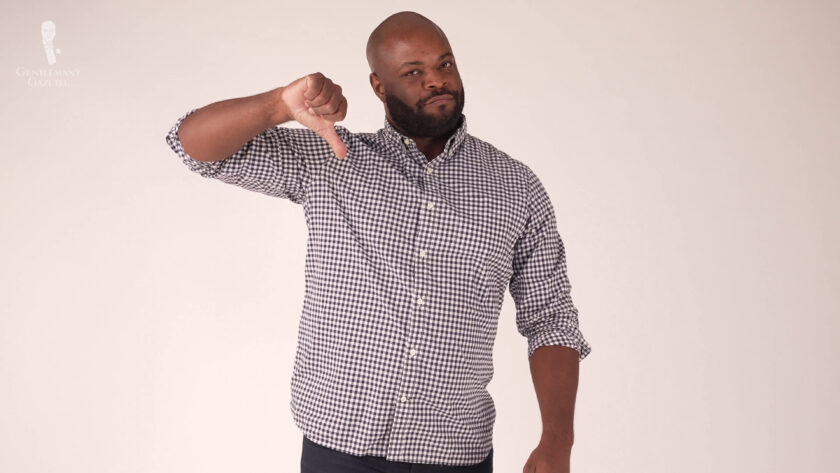
Under most circumstances, we advise you to avoid $100 suits unless you need to wear them for an extremely limited amount of time under very particular circumstances.
Suits that are designed to be sold for $100 are made to be cheap by design: cheap fabric, cheap cuts, cheap labor, and cheap details. If you think about it more, it makes perfect sense: the retailer has to make some money, the sewer has to make some money, and the factory owner who employs a sewer wants to make money. At the end of the day, there’s not much room left to add anything of quality.

“It is my verdict that a retail suit made to be sold for $100 is never worth it. From day one, they are intentionally cheap, employing low-quality materials, and it won’t take very long for them to start falling apart, meaning that you’ll just have to buy a new suit.”
Raphael Schneider
As a result, these suits look and feel cheap as well. Ignoring additional potential factors, such as working conditions in sweatshops and the environmental impact of cheaply-made clothing, it is simply very difficult for a suit made with an emphasis on low quality to offer any quality hallmarks or a quality wearing experience.
Therefore, we suggest that you avoid buying a suit intended for retail for $100 if you can: there are better alternatives available to you that will allow you to acquire a garment of higher quality for a similar price.
Is $100 Your Budget? Buy Vintage!
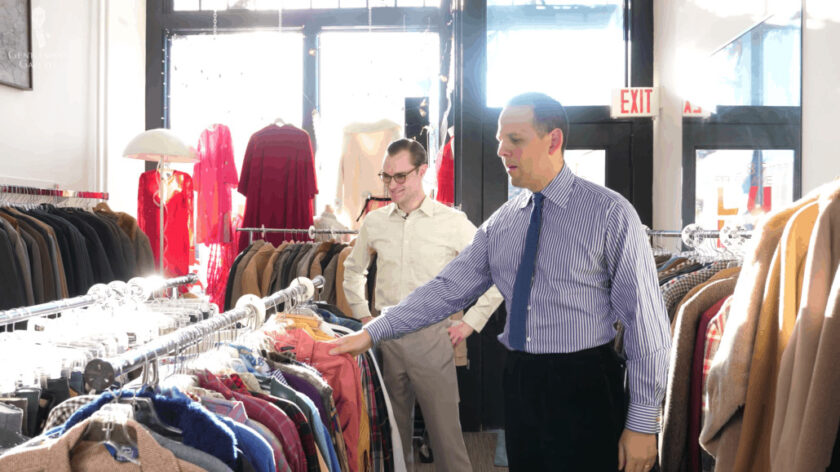
What treasures could you find in a vintage shop?
If you only have around $100 or less to spend on a suit, you do not need to resign yourself to a low-quality suit. Raphael, Preston, Kyle, and Nathan have all had to work within this budget at one point, and their secret is to buy a used suit!
Used clothing allows you to acquire suits at higher price points and higher levels of quality that are cheaper simply because they are not brand new. Many of these items are gently worn, and sometimes even completely unworn, but because they are being resold, they can be acquired for a fraction of their original cost.
Learn these secrets to vintage shopping!
FAQ
What are the main differences between an expensive suit and an inexpensive one?
It is difficult to generalize about what distinguishes an expensive suit from a cheap suit, but some general hallmarks are typical. Due to its low price point, an inexpensive suit is likely to have lower quality fabrics to keep overall costs low. It is also unlikely that an inexpensive suit will have the benefits of quality construction, carefully prepared patterns, and fine detail typical of an expensive suit, simply because the maker cannot afford the time and materials necessary to achieve these results.
Are expensive suits made from better materials than inexpensive suits?
As a general rule, expensive suits are made from high-quality fabrics like wool, cashmere, or silk. Fabric can be one of the most expensive components of a suit, and so if a manufacturer has to keep the final product at a low price, cheaper materials, like synthetics, are a simple way to do so.
Are all expensive suits worth the price?
While most expensive suits offer high-quality craftsmanship, it’s always recommended to do thorough research before purchasing. Factors such as brand reputation, material sourcing, and individual preferences must be considered. Sometimes, certain brands may overprice their products without offering significant advantages over more reasonably priced options. Learning the hallmarks of genuine quality outlined in this article will help you locate the right suit for you.
Does the construction of the suit affect the price?
Yes, it does. Expensive suits are carefully constructed with precision, utilizing techniques such as hand-stitching to ensure flexible movement and a full or half canvas for superior structure. These processes require additional time and resources, so cheaper suits usually employ mass production methods, which can result in lower durability, fit issues, and increased discomfort.
What is the interlining of a suit jacket?
Interlining refers to a layer of material, usually sandwiched between the lining and the outer shell of the jacket, that helps the jacket maintain its form and structure. On inexpensive suits, the interlining is usually glued or fused into place. On expensive suits, it is either partially or fully sewn into place: the former is known as “half canvas” and the latter as “fully canvassed.”
Can an inexpensive suit still look good if properly styled?
Yes, it’s possible to make an inexpensive suit look good with proper styling. By focusing on fit, pairing it with complementary accessories, and ensuring it’s well-pressed, you can enhance its appearance. However, it’s important to note that the overall quality and longevity may not match that of an expensive suit; you could invest considerable resources in making an inexpensive suit look great, only to have it later fall apart on you.
Can an inexpensive suit be upgraded to imitate the features of an expensive one?
Although you can enhance an inexpensive suit by altering certain aspects like fit or adding better buttons, it’s challenging to completely replicate the features of an expensive suit. High-end materials, meticulous construction techniques, and exquisite details contribute to the distinctiveness of an expensive suit, making it hard to imitate on a low-budget garment.
Is it better to own a few expensive suits or several inexpensive ones?
It depends on personal preference and lifestyle. Owning a few well-made, expensive suits can provide versatility and long-term value. On the other hand, having several inexpensive suits can offer variety for different occasions at a lower initial cost. Ultimately, it’s about finding a balance between quality, quantity, and individual budget considerations. In our opinion, when building a Classic Wardrobe, it is always better to invest in quality over quantity, with an emphasis on versatile, timeless, and durable garments.
The Features of a $1000 Suit
Quality Usually Has a Price
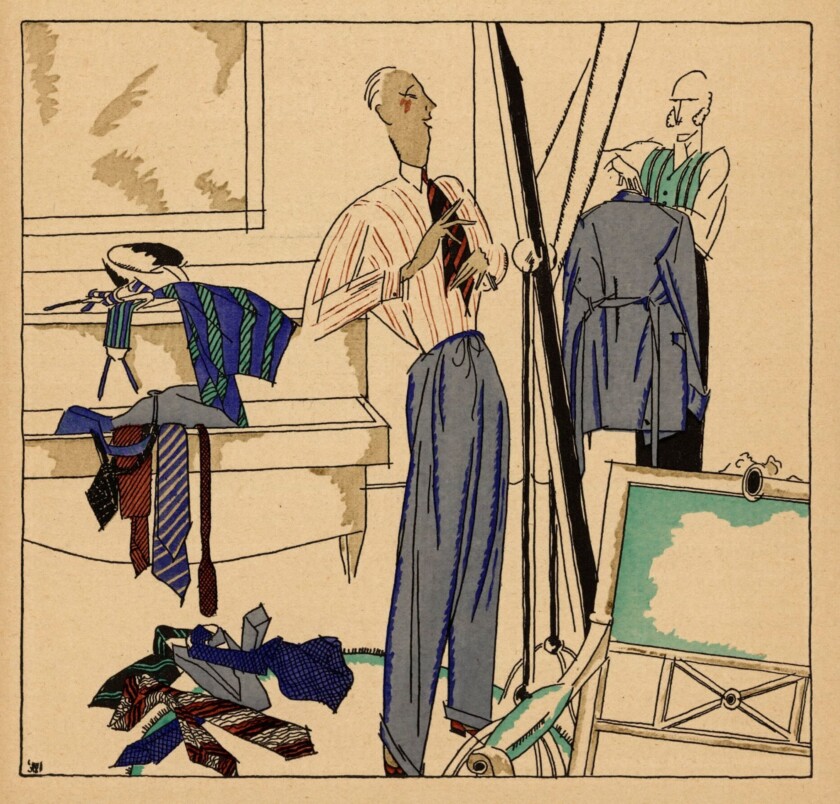
Few pleasures compare to trying on a high-quality suit, and that pleasure often comes at a cost.
Suits typical of the $1000 price range do not have the razor-thin margins typical of cheaper suits, meaning that they are far more likely to feature cuts, detailing, and materials conducive to an elegant, aesthetically pleasing, and comfortable wearing experience.
What are you getting when you buy a suit worth $1000?
A high Price does not equal
Good Value
When speaking of $1000 suits, it is important to distinguish between a suit that is worth $1000 and a suit that costs $1000. Many fashion brand suits have prices that are inflated because of the brand name but have hallmarks typical of cheaper suits.
Find out what luxury products are worth their price!
Construction

Skilled workers must be paid, and often handsomely, for the handwork that they do on expensive suits.
$1000 suits have a variable degree of time and effort that can go into their construction, with labor time varying from between 8 hours and over 30 hours. The location of work also matters: a suit manufactured in London, England or Milan or Rome, Italy may be made to the same standards as one from Hong Kong or Thailand, but the higher cost of wages in the former will increase the cost of the suit.

“I’m expert at this, making a show. Shoes: Handmade. Suit: Bespoke.”
Stanley Baker
Generally, a $1,000 suit shows some amount of handwork. Sometimes, this handiwork is restricted to decorative elements, but it can also include functional details like a hand-sewn interlining or collar for improved comfort and a superior fit.
Big fashion brands like Canali, or Armani, or Dolce & Gabanna, usually have less handwork, but they do place an emphasis on a refined style and pattern. On the other hands, suits from Asia may have more handwork because the labor is less expensive but the styling can sometimes be a little old-fashioned because they are working off of older, more established patterns.
Learn how to spot a quality suit
Shell and Lining Materials
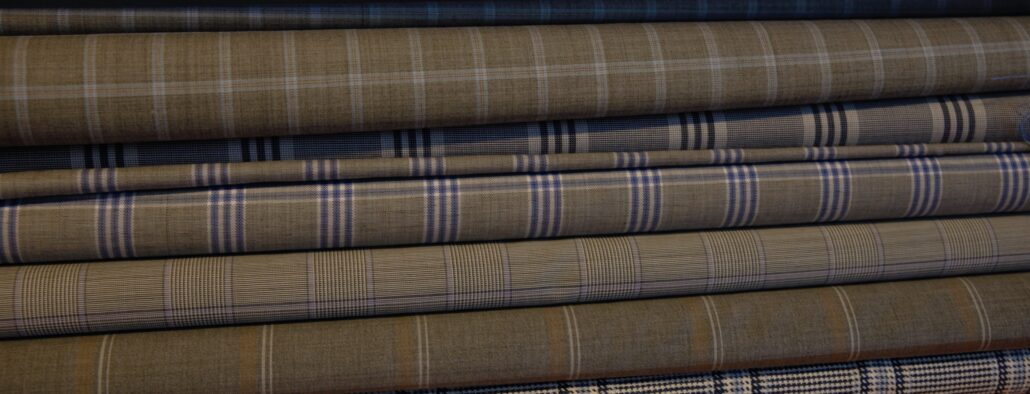
Bolts of Vitale Barberis Canonico wool

Irish Linen
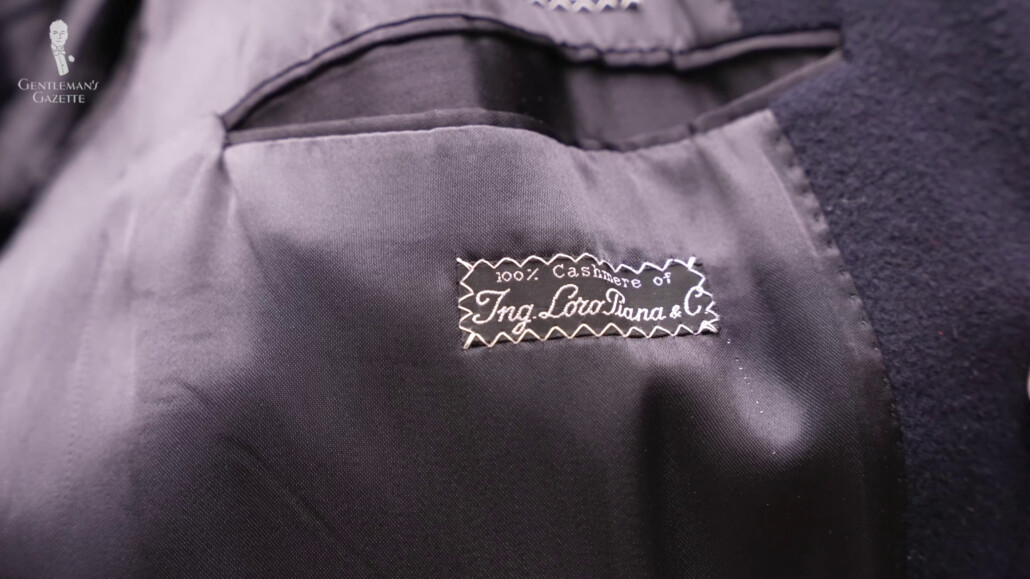
Loro Piana cashmere
Luxurious fabrics have always been a defining feature of fine garments, and at $1000, you are more likely to encounter cloth of at least a decent quality that possesses good durability, a soft feel that is comfortable, and a pleasing drape.
Suits will be made from quality wool or linen and perhaps even blends of luxury materials like cashmere or vicuna. Because these fabrics have a higher upfront cost, it is more likely that the resulting suits will be of higher quality: one is generally less likely to expend money on an expensive fabric and then employ subpar quality standards that reduce its overall value.
Interlining
How the interlining is constructed is the single biggest advantage that a $1000 suit has over a $100 suit because of how much is improves drape and comfort.
$1000 suit interlinings are made in one of two ways: Half Canvas or Full Canvas.
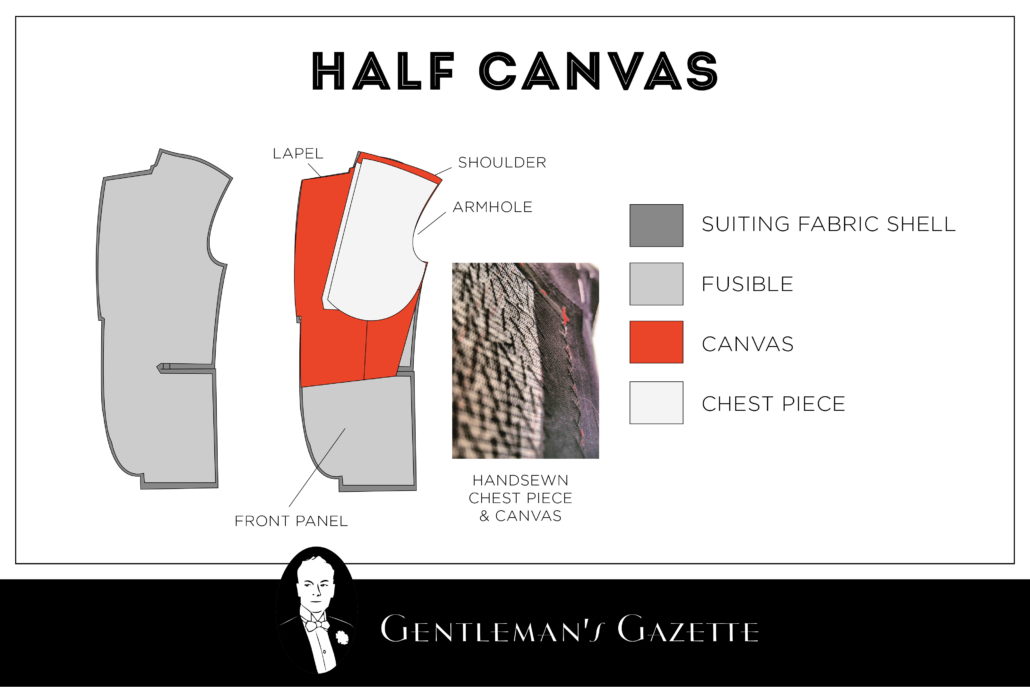
Half Canvas
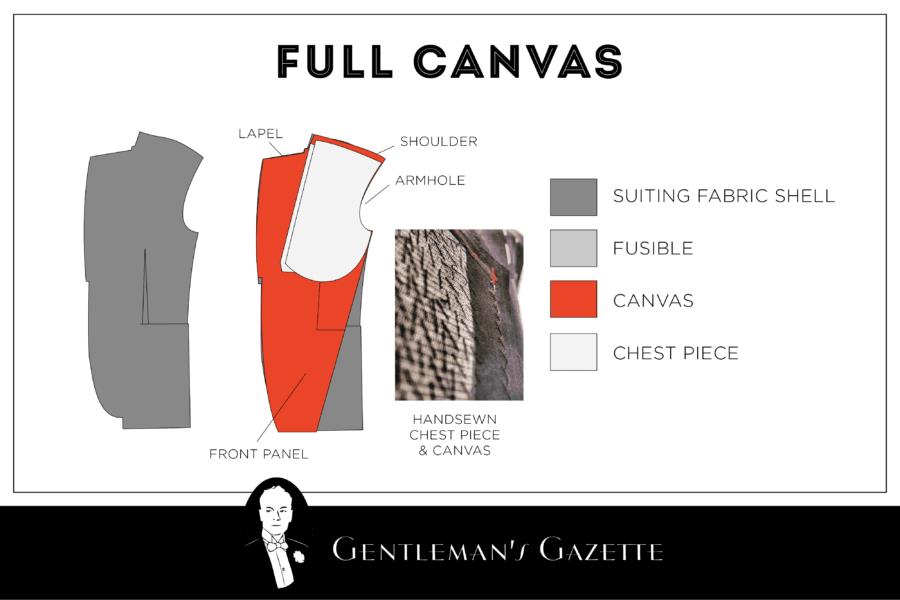
Full Canvas
| Half Canvas | Full Canvas |
|---|
| A half canvas is sewn to the fabric and is usually made of materials such as horsehair, cotton, or wool. These natural fabrics are more breathable, so you don’t overheat. As a consequence, you’re less likely to sweat, and it moves with you on your body, so it’s more comfortable. To save on cost, this form of interlining is only used on the upper part of your body such as your chest and it’s glued at the bottom part of your jacket. | Full canvas means that the interlining is sewn throughout your jacket, and it’s the best version you can get. At a thousand-dollar price point, usually, these canvases are made by machine and not by hand. Sewing by hand would be the better option, but this operation is very time-intensive and, for a thousand dollars, it is usually not practicable to apply the canvas fully by hand. |
Attention to Details
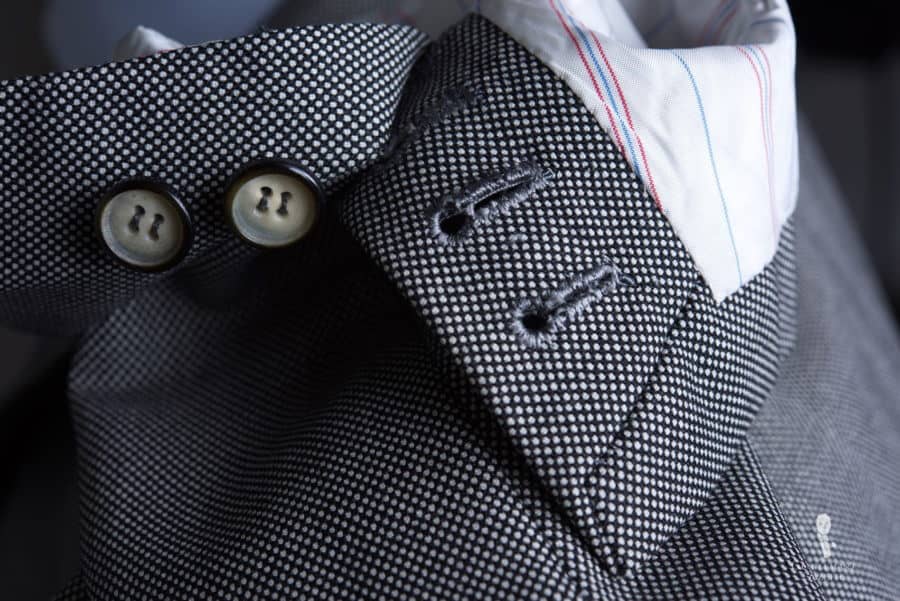
Handmade buttonholes
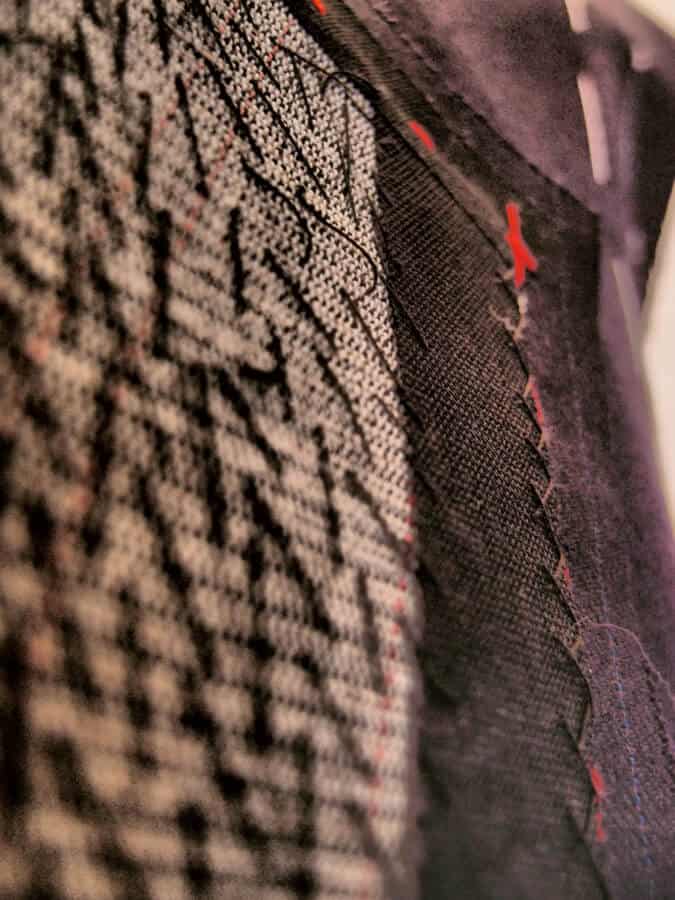
Handsewn canvas on a lapel
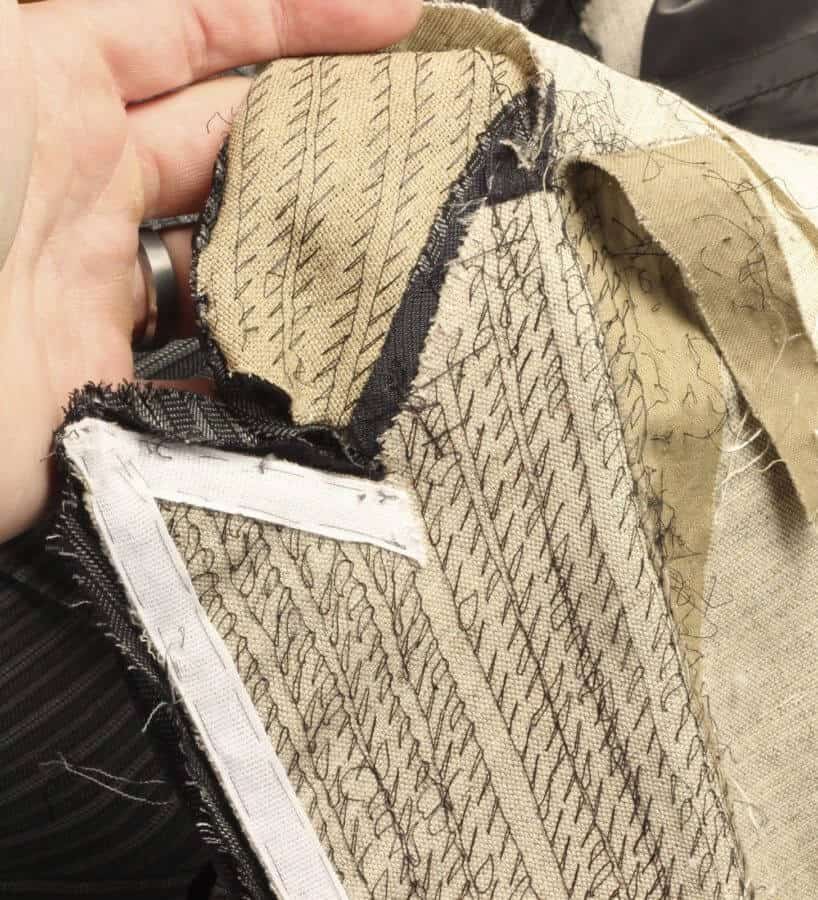
Neat machine-sewn lapel interlinings
At the $1,000 price point, clients expect finer detailing, and manufacturers will often oblige. These details most often include handmade buttonholes, which appear far neater and more elegant than their machined counterparts. Threads with beautiful, high sheens, usually made from silk or quality cotton, are also employed. Portions of the interlining may be sewn by hand or carefully applied by machine.
These details are small, but taken together, they can vastly improve the experience of wearing a suit.
See all of our fabric content
Cut
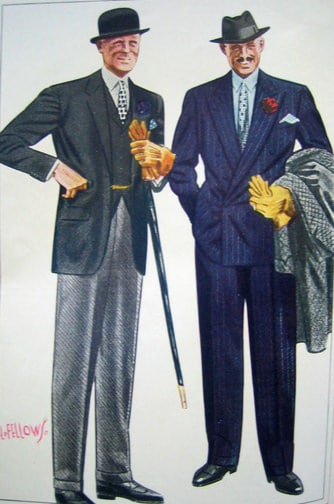
Classic suit cuts
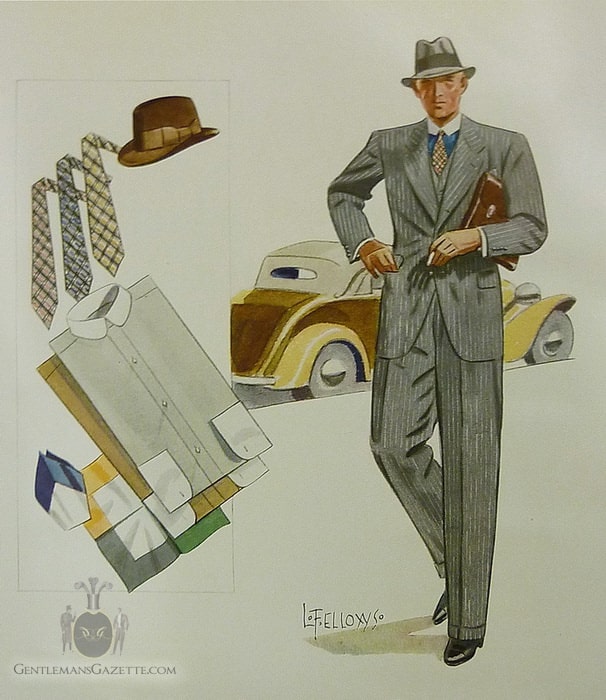
Classic suit cut
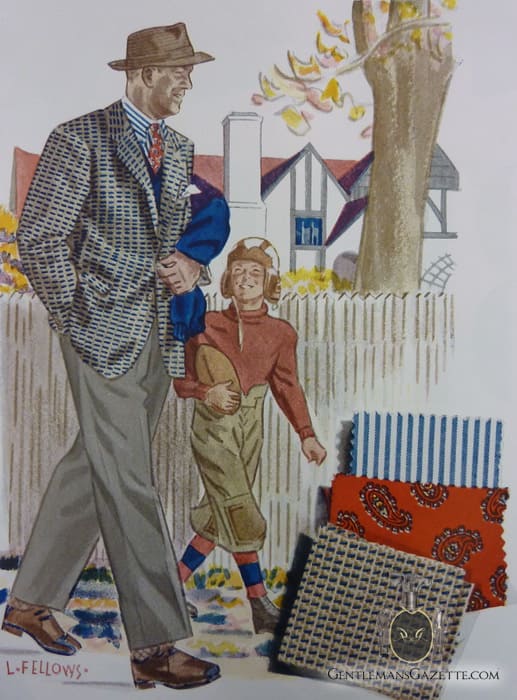
Classic suit cut
$1000 are generally cut with more versatile, flattering, and timeless lines because they were designed by a maker who understands both fashion and what looks best on most men: at this price, happy clients are a must! Neither overly trendy nor excessively traditional, they are more likely to walk the fine line of good taste because time and effort have been expended on this element, as is reflected in the price.
Do you prefer the British, American, or Italian-cut suit?
Pattern
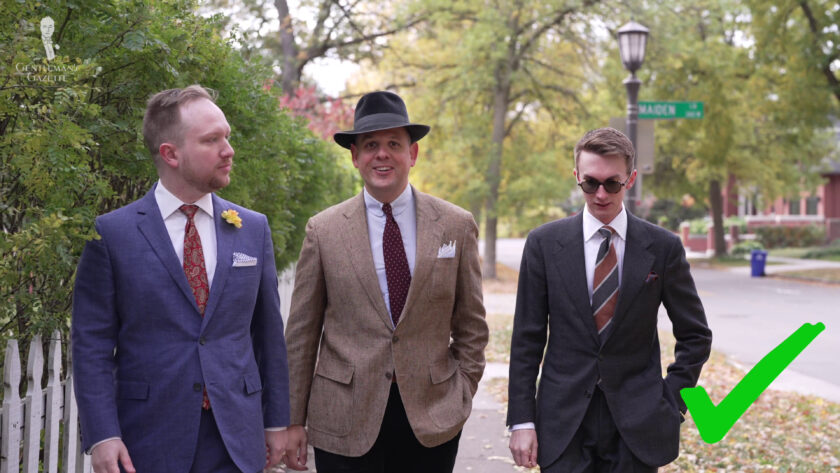
$1000 suit patterns are more likely to fit a wider variety of body types.
Similar to the cuts, the patterns of $1000 are intended to be versatile. These patterns can be molded to a variety of body types because the patterns are planned with give, such as reserve fabric, to allow for easier alterations, a superior drape, and to lie more naturally on the body.
What your tailor can do to improve fit
Quality $1000 Suits Are Generally a Good Investment

While expensive, $1,000 suits can be a great investment.
When you are attentive to what makes a $1,000 suit truly high-quality, you can often source a suit that is a pleasure to wear, will help you look your very best, and offers exceptional cost-per-wear.
At this price point, however, you cannot afford every detail that makes a truly spectacular suit. You will have to compromise: you either can get something with more handwork that is a little more comfortable and lasts longer or maybe something that is more machine-made with a more refined cut, but you have to compromise on the fabric.
Ultimately, however, your purchase will offer superior returns when compared with a $100 suit.
Compare a $500 suit to a $5,000 suit!
How to Quickly Identify a Quality Suit
Raphael does this as soon as he enters any store
No matter if you spend a hundred dollars or a thousand dollars, this little secret will help you save a lot of money and to get quality suits.
When I walk into a store and look at suits, the first thing I do is to unfold the collar and look at the stitching.
If it is machine-sewn with a zig-zag stitch, I move on, especially at a vintage store. If it’s hand-sewn, I take the jacket off and take a closer look. I do this because a hand-sewn collar indicates a very high quality and if the collar is handsewn, it is very likely that you have a sewn full canvas interlining, and fine details.
How to tell if a collar is machine or handsewn
A machine sewn collar has very regular zigzag stitches or in general consistent stitching. On the other hand, a hand-sewn collar has irregular stitching. It will take a bit of time to practice. Ideally, you start looking at machine made jackets, then you know what they look like. And then you look at one that is hand-sewn. Eventually, you will be able to tell which one is which with 100% accuracy.
This trick saves you time and money
If I go into a vintage store with 300 suits, there are probably only going to be 3-5 suits that are hand-sewn. Using this method, I can quickly go through the entire store and look at the ones in my size and determine if it’s worth staying there or not. If the collar is hand-sewn, chances are, it’s a high-quality garment, and it deserves a second look, and you can use the hallmarks I described in this guide to identify if you should buy it or not.
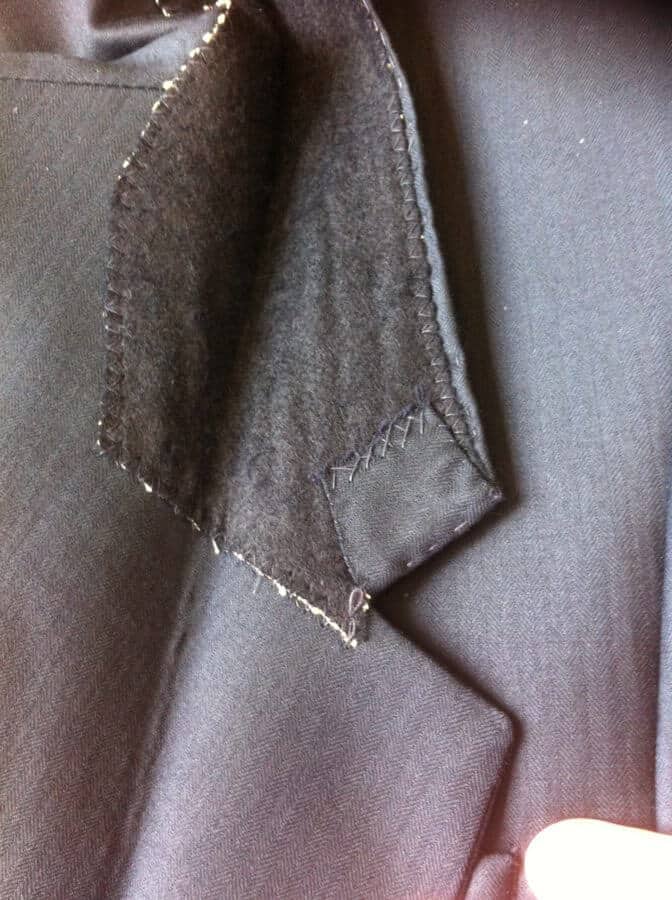
The perfectly neat stitching on a machine-sewn collar.
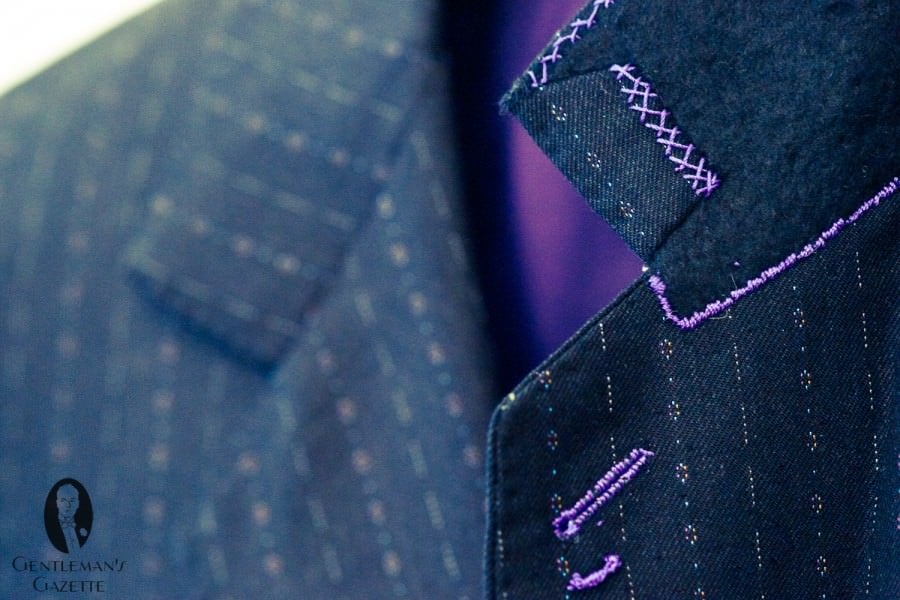
This hand stitching is very fine, but it still has irregularities.
Conclusion

Whether you spend $100 or $1,000, we want you to spend your money wisely!
Ultimately, only you can decide how much you are willing to spend on a suit based on your particular needs. With the information in this guide, you are now able to make informed decisions while carrying out your purchase because you know exactly what to expect at both the $100 and the $1,000 price point.
Tell us in the comments about your experiences with $100 and $1,000 suits!
https://www.gentlemansgazette.com/100-dollar-suit-vs-1000-difference/
Did you miss our previous article...
https://manstuffnews.com/men-fashion/6-leather-goods-essentials-from-jj-leathersmith
 Backyard GrillingWeekend WarriorsAdvice from DadBeard GroomingTV Shows for Guys4x4 Off-Road CarsMens FashionSports NewsAncient Archeology World NewsPrivacy PolicyTerms And Conditions
Backyard GrillingWeekend WarriorsAdvice from DadBeard GroomingTV Shows for Guys4x4 Off-Road CarsMens FashionSports NewsAncient Archeology World NewsPrivacy PolicyTerms And Conditions
